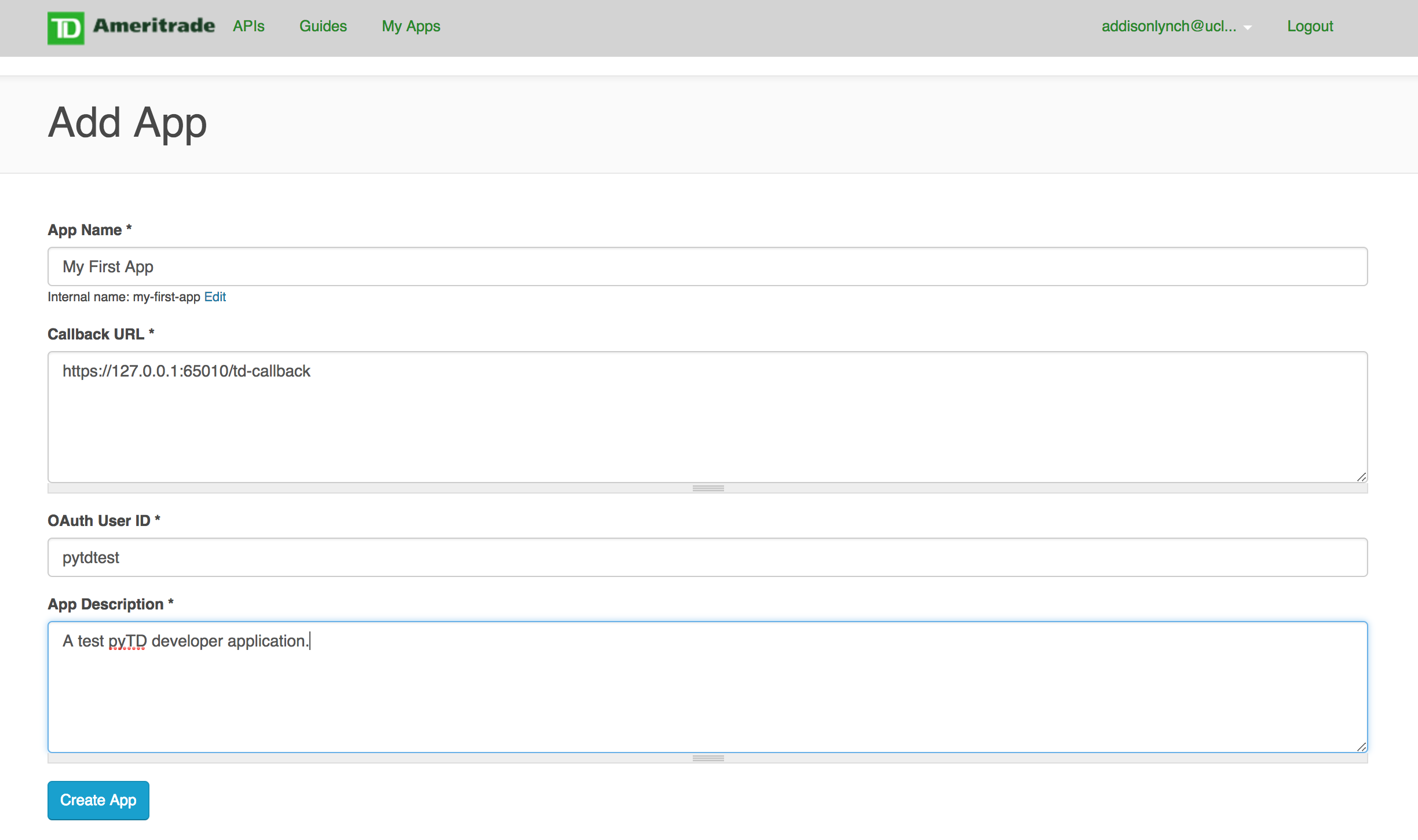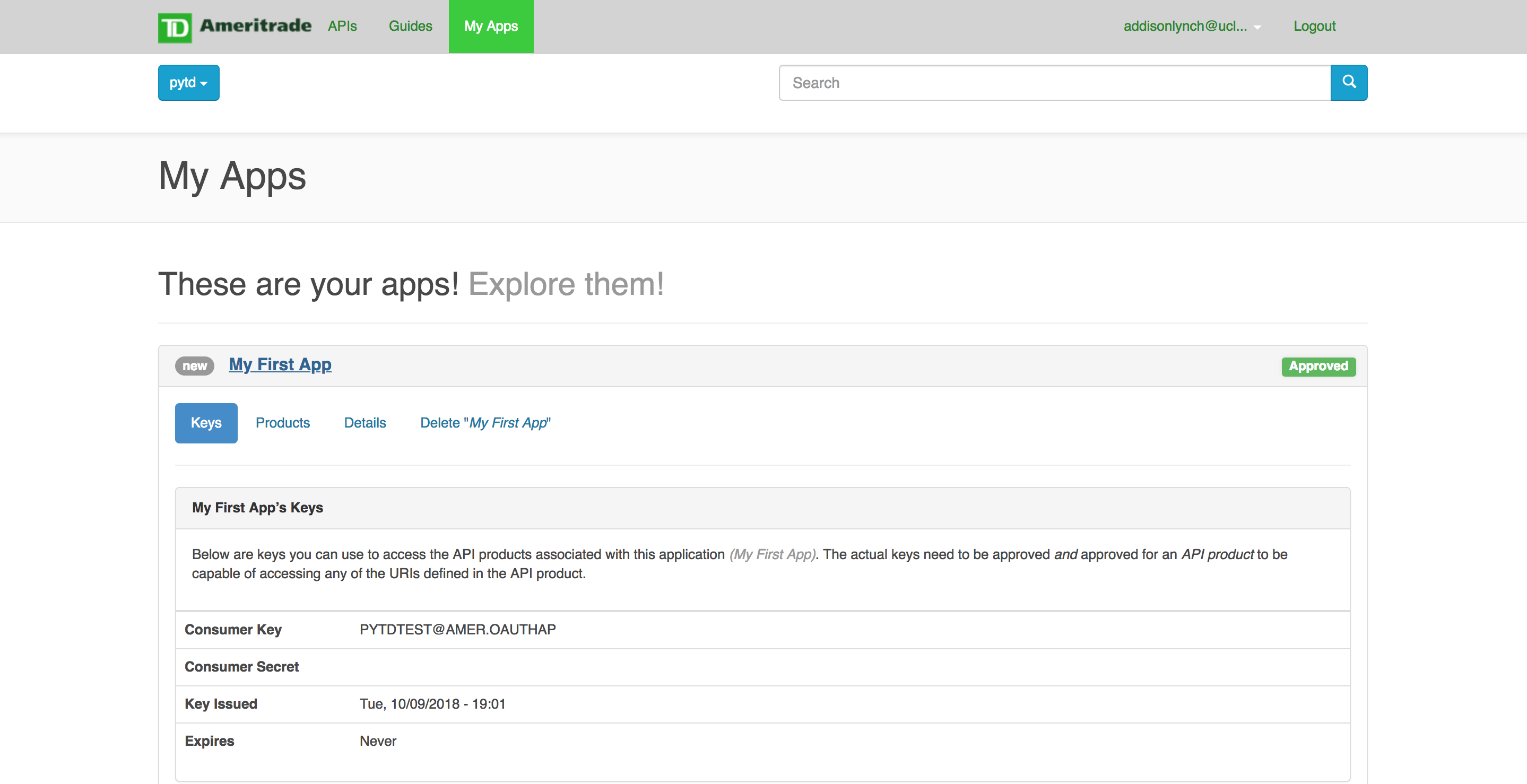Frequently Asked Questions¶
What is OAuth 2.0?¶
From RFC 6749:
The OAuth 2.0 authorization framework enables a third-party application to obtain limited access to an HTTP service, either on behalf of a resource owner by orchestrating an approval interaction between the resource owner and the HTTP service, or by allowing the third-party application to obtain access on its own behalf.
In other words, OAuth 2.0 is the protocol that TD Ameritrade uses to help you gain access to the Developer API (and your account). There are four roles in this process:
1. Resource Owner - an entity capable of granting access to a protected resource. In this case, YOU.
2. Resource Server - the server hosting the protected resources, capable of accepting and responding to protected resource requests using access tokens. In this case, TD Ameritrade’s servers.
3. Client - An application making protected resource requests on behalf of the resource owner and with its authorization. In this case, pyTD (or an application which uses it).
4. Authorization Server - The server issung access tokens to the client after successfully authenticating the resource owner and obtaining authorization. In this case, your application or local authorization server.
What should my Callback URL be?¶
This raises an important question: What is a Callback URL?
From RFC 6749:
The authorization code is obtained by using an authorization server as an intermediary between the client and resource owner. Instead of requesting authorization directly from the resource owner, the client directs the resource owner to an authorization server (via its user-agent as defined in [RFC2616]), which in turn directs the resource owner back to the client with the authorization code….
… Because the resource owner only authenticates with the authorization server, the resource owner’s credentials are never shared with the client.
As explained in What is OAuth 2.0?, the resource owner is you - as you have the access to your TD Ameritrade brokerage account. In order to prevent your account credentials from being revealed, authentication is completed with an authorization server.
Default pyTD behavior is to start this server locally, running on your
localhost (typically 127.0.0.1). If this is the case, your Callback URL
should be https://localhost:8080.
What is a self-signed SSL certificate?¶
An SSL certificate certifies the identity of an entity such as your local pyTD authentication server. Self-signed SSL certificates are signed by the same entity which they are certifying the identity of.
This may cause problems for some browsers, which will display messages such as “Your connection is not private” and “This site’s security certificate is not trusted!”. This is due to the fact that your application is not a trusted certificate authority.
How do I create a self-signed SSL certificate and key?¶
There are a number of different options for generating a self-signed SSL certificate and key.
The easiest way: OpenSSL¶
OpenSSL is an SSL/TLS toolkit which is useful
for generating SSL certificates. Once installed (see system-specific
installation instructions below), run the following command to generate key
and certificate files key.pem and cert.pem:
openssl req -newkey rsa:2048 -nodes -keyout key.pem -x509 -days 365 -out cert.pem
How do I get my Consumer Key and Callback URL?¶
A TD Ameritrade Developer account and application are required in order to access the Developer API. This is a separate account from TD Ameritrade Brokerage Accounts. A TD Ameritrade Brokerage Account is not required to obtain a TD Ameritrade Developer Account.
To register for a TD Ameritrade Developer account, visit https://developer.tdameritrade.com/ and click “Register” in the top-right corner of the screen.
Creating an App¶
To create a new TD Ameritrade Developer Application, navigate to the “My Apps” page of your TD Ameritrade Developer Account:

My Apps Page
From here, click the “Add a new App” button:

Creating an app
You will be prompted to enter the following fields:
- App Name - desired application name
- Callback URL - also known as Callback URL, this is the callback address to complete authorization
- OAuth User ID - a unique ID that will be used to create your full OAauth ID
- App Description - a description of your application
After completing the form, your application will be created. By clicking on the application in the “My Apps” page, you can display information about it:

App Info
The Consumer Key field is your Consumer Key. Your Callback URL is the Callback URL which you entered at the app’s creation.
Note
To change the Callback URL (Callback URL) of your application, you must delete the application and create a new one. This is a caveat of the TD Ameritrade registration process.
What is a Script Application?¶
A script application is simply an application that is run as a script from your local environment. This may be a stand-alone script that is run which uses pyTD or command-line invocation of pyTD, such as running:
>>> from pyTD.market import get_quotes
>>> get_quotes("AAPL")
in an interactive Python shell.
What is a CUSIP ID?¶
A CUSIP is a nine-character alphanumeric code that identifies a North American financial security.
Simply put, CUSIPs are unique identifiers for a number of financial instruments including common stocks, bonds, and other equities.
Examples¶
- Apple Inc.: 03783100
- Cisco Systems: 17275R102
- Google Inc.: 38259P508
- Microsoft Corporation: 594918104
- Oracle Corporation: 58389X105
Is it safe to save my authentications on-disk?¶
Note
TODO